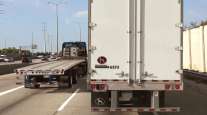Senior Reporter
Speed-Limiter Plan ‘Flawed’; ATA Preps Response to DOT

This story appears in the Oct. 10 print edition of Transport Topics.
LAS VEGAS — American Trucking Associations President Chris Spear sharply criticized a proposed federal speed-limiter rule for new heavy trucks as “flawed” largely because it would create differential speeds on the nation’s highways.
“Proposing a rule that does not take into account the various differentials in speed between what this rule proposes and what state speed limits are is dangerous,” Spear said at an Oct. 4 news conference here at ATA’s Management Conference & Exhibition. “The agency has a responsibility to study it, to provide data, to come to a consensus about one speed and one national limit, not three, and no national limit.”
The proposal, published Sept. 7 jointly by the Federal Motor Carrier Safety Administration and National Highway Traffic Administration, does not specify a speed that will be adopted in a final rule but suggests that setting the limiters to 60, 65 or 68 would save lives and reduce fuel use.
MCE PHOTO GALLERY: Best pictures from Las Vegas
COMPLETE MCE COVERAGE: Live stories, photos, video, social media and more
“I find it rather curious that the administration waited nearly eight years,” Spear said. “We’ve had this policy in petition, and we’ve testified on the Hill on this issue over the course of 10 years. They waited for eight years, the administration, to put forth this proposal.”
Spear added: “What is this proposal? Is this really a proposal? It’s three speed limits, not one. It has no data, no studies, nothing to back it. It has no national cap for limit to address the differential that now exists, or would exist, or would we find one effective between what state speeds are, and what our trucks would be governed at.”
Spear said the nation cannot afford to “elevate risk to the motoring public.”
ATA initially petitioned the agency in 2006, requesting speed limiters be set for all heavy trucks at 68 mph, but in 2008 the federation endorsed a national speed limit of 65 mph for all vehicles, not just trucks.
Spear said the limiter rule had been the subject of “robust discussion” during the four days of MCE.
He said ATA’s policy position will not change in the “foreseeable future” and that the federation will provide comment on the rule prior to the Nov. 7 deadline.
The rule requires that the devices eventually would need to be capable of verification by regulators or law enforcement via onboard diagnostics. It does not require that the limiters be tamper-proof.
NHTSA estimates that the rule will result is a fuel savings and greenhouse-gas emissions reduction of $848 million annually for 60 mph and 65 mph speed-limiter settings and $376 million annually for 68 mph setting.
FMCSA Administrator Scott Darling declined comment on the proposal.
“Right now, we really can’t talk about it because it’s in the notice of proposed rulemaking stages,” Darling told Transport Topics. “We’re looking to get comments. We’ve got 2,400 comments already. We want as many comments as possible.”
Darling said the two agencies are considering expanding the comment period by as much as two months. ATA asked for a 30-day extension via letter to Transportation Secretary Anthony Foxx.
Thomas Balzer, president of the Ohio Trucking Association, said his membership two weeks ago formally issued a policy position opposing the proposed rule because it lacked research to support it.
“I really feel that the purpose of the proposed rulemaking is for the agency to build its case, to be able to support it and to give the public the opportunity for critical input,” Balzer told TT. “It’s unfortunate part is this just seems like a fact-finding mission. They’re looking for the research to be developed through the comment period, which is not the intention of the comment period.”
Balzer added, “It’s a scenario that is not ideal in the rulemaking process. It’s difficult for the industry to intelligently respond.”
Matt Hart, executive director of the Illinois Trucking Association, said he, too, has concerns that the agencies failed to back up the rule with data.
“The maximum speed limit in Illinois is 70 mph,” Hart said. “Anything below that would automatically create a speed differential.”
Hart said his organization’s review of the research on speed differentials has shown that the safest states are those that have a uniform 65 mph speed limit.
“The data is readily available from the Federal Highway Administration,” Hart said.
Road Safe America President Steve Owings has called the proposed rule “absurd.”
“I’m glad that we got something we can react to, but react we must,” Owings said. “As proposed, it would only apply to future trucks. How outrageous.”
State maximum truck speed limits vary widely throughout the United States. For example, Texas allows trucks to go 85 mph on some interstates, and top truck speed limits in Wyoming, Nevada, Utah and South Dakota are 80 mph.
Nine states allow trucks to go 75 mph, 21 allow 70 mph, 10 allow 65 mph, three allow 60 mph and two allow 55 mph.




